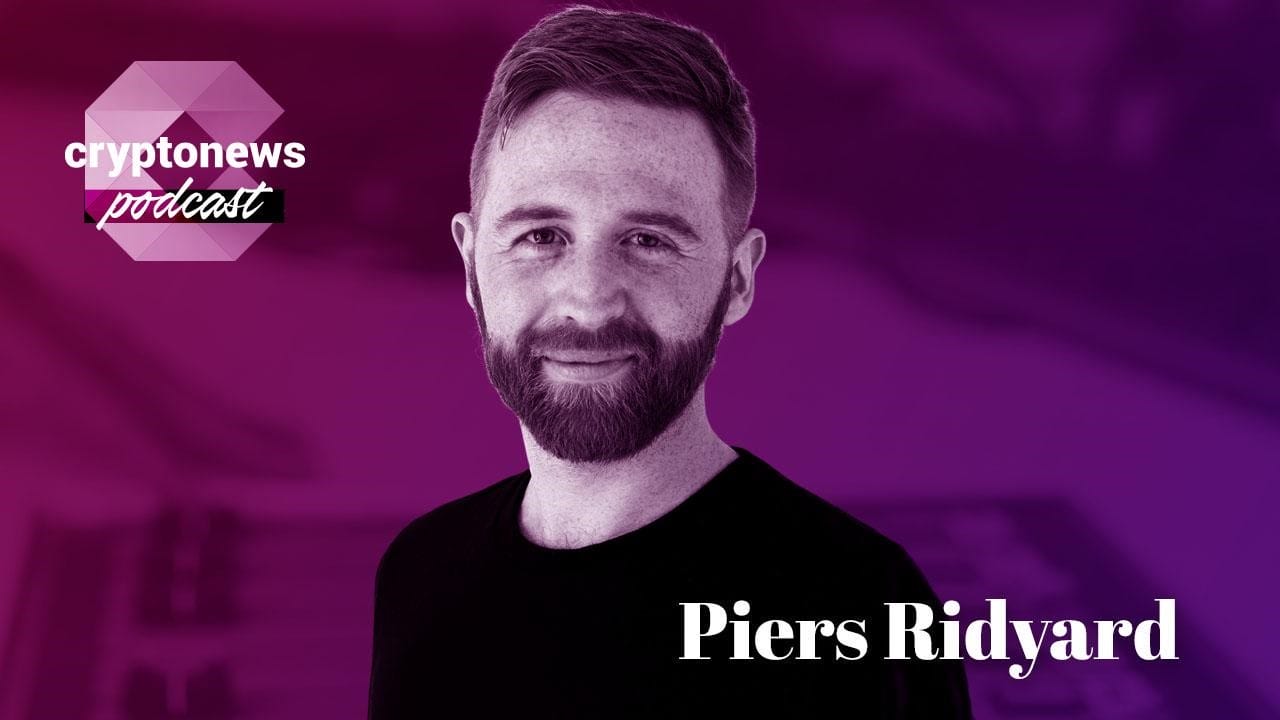Piers Ridyard, CEO of Radix DLT, on The Future of Web3, Wallets, Account Abstraction, and Creating the Game Engine for DeFi | Ep. 315

In an insightful interview, Piers Ridyard, CEO of the decentralized network Radix DLT, discussed his “wild ride” through the worlds of smart contracts and Y Combinator.
Chatting with Cryptonews Podcast host Matt Zahab, the CEO talked about finding Ethereum, mining on its genesis block, selling ETH, and getting into Radix.
Ridyard told us about the project’s key principles, and how it goes above and beyond to keep users’ funds safe.
In this interview, Ridyard discussed:
- the founding story of Radix DLT;
- Y Combinator’s secret sauce: setting the tone and levelling up in business;
- Radix having a much simpler coding language than other blockchains;
- Radix as a game engine for DeFi: it is significantly quicker to build applications on;
- how Radix Wallet improves crypto user experience.
Piers Ridyard gave a wide-ranging exclusive interview, which you can watch above – or you can read a part of it below.
Wild Ride Through Smart Contracts and Y Combinator
Ridyard started the interview with his background. Notably, he described his experience with Y Combinator as “a wild ride.”
First, he entered the Ethereum community very early and got very interested in smart contracts.
At the time, smart contracts were a new thing in the space, and everybody wondered what they could create. Ridyard finds that most of these ideas will come true, it’s just a matter of timing.
But he had something specific in mind:
“One of the things that I thought – it was an obvious use case for smart contracts – was insurance.”
Ridyard started “playing around” with this idea of automatic insurance. Having no knowledge about insurance, he first reached out to “a bunch of” insurance companies to understand their problem set.
He talked to them about blockchain, and they told him about insurance. “So I ended up speaking with a bunch of the senior people in some of the biggest insurance companies in London.”
However, the crypto sector was very different at the time and was ultimately not equipped to facilitate automatic insurance. Specifically, there were no stablecoins.
They could only use ETH as collateral, and that wouldn’t work, he said.
Meanwhile, Ridyard learned from the insurance companies that their sector was a slow, manual, disorganized “mess.”
Soon, he began the process of product discovery and came up with the idea of Surematics: a way of creating smart contract-based deals around large syndicated insurance deals.
It would enable the control of the programmatic flow of money, creating criteria for insurance, and more.
He went on to apply for Y Combinator. And Surematics got in.
Y Combinator taught him that,
“There can be a million excuses, but if you want to be successful, this is what you have to achieve. Either you’re going to move heaven and earth to achieve that, or you’re not going to be as successful as you could be, and that’s your choice. We’re not going to give you shit for not doing it, we’re just going to be like, this is the bar and this is what you need to get to. And that changed my perspective from that point forward.”
And at the same time, Ridyard “started playing around” with other blockchain technologies because he had realized that Ethereum had a number of issues.
He soon discovered this new platform called Radix and became friends with its founder Dan Hughes. He then decided to build Surematics on top of Radix.
Why should you apply to YC?https://t.co/jMbniHoJK4 pic.twitter.com/NBDxvlqkwf
— Y Combinator (@ycombinator) April 4, 2023
Mining On the Genesis Block
In July 2015, Ethereum created its “genesis block,” i.e. the first block in a blockchain.
Ridyard was one of those mining on the Genesis Block. More precisely, he had already set up the mining equipment before the Ethereum mainnet launch.
He stated that,
“I think we probably mined maybe in the top 50 blocks, something like that. And so it was a really weird entrance into crypto for me because it started from a point of complete skepticism.”
When he first learned about Ethereum from a friend, he wondered if either of them should invest. Ultimately he told his friend it was a scam and not to buy it.
However, Ethereum started testnet mining a few months later, and “I was like, oh shit, I’ve taken a completely wrong view on this.”
Following some intensive research, he realized that they “just need a bunch of GPUs.”
Notably, before he got into crypto, Ridyard had manufactured consumer electronics for the Apple market. So mining was “right in my wheelhouse.”
They bought “a bunch of hardware” and started mining on the testnet. And then they simply continued mining on the mainnet.
“And we were mining sequential blocks at many points where we would win a block, and then we’d win the next block. And that’s how low the computing power was at the time.”
Ridyard was there for many of Ethereum’s firsts.
Following his mining entry, he got into smart contracts, invested in the first decentralized autonomous organization (DAO), known for The DAO hack, and was there during the debates about whether or not Ethereum should fork.
Meanwhile, he sold most of the mined ETH.
“I think we mined 10,000 ETH in about three months. But the irony of it was if we’d taken the money that we’d spent on hardware and just bought Ethereum, we would have done about 5X better than we did through mining.”
That said, Ridyard wanted to buy his first house, and he had enough money from mining to make a deposit.
There appeared another irony. This one hurt. It took six months to close on the house. By that time, he could have bought the house in cash.
On the other hand, he had put his ETH in various wallets. When he opened one of them previously holding about $300-500 in ETH, he found it reached $20,000.
“I think the thing that I learned from that is never sell your moon bag,” Ridyard said. “Always make sure that you’re always holding something. But yeah, Ethereum has definitely treated me well.”
Today marks the 8th anniversary since the Ethereum genesis block.
One of the most significant moments in crypto so far.
Happy birthday to Ethereum! 🎂 pic.twitter.com/rKezCxTZWl
— Binance (@binance) July 30, 2023
The Core of Radix
Ridyard noted that the technology of Radix excited him “way more” than the application of insurance.
The three things that make the core of Radix, and that the team delivered, are scalability, developer experience and tools, and user experience.
The company took a thorough approach, thinking:
“Let’s take a bit more time, and let’s actually work with developers to get to the point where you have a programming language that feels really intuitive for doing the things in Web3 that make sense”.
Therefore, they spent about two years talking to about a thousand developers.
They knew that the syntax had to be “super easy” as well.
The team kept iterating until they got it to the point where “developers are just getting it immediately” once they went through the documentation.
“They spend an hour going through it. And they’re like, I understand how to build Uniswap, I understand how to build Aave.”
That’s when they released the programming language at the end of 2019. It has grown “incredibly well” since.
They also worked thoroughly on what the user experience (UX) paradigm needed to look like.
The team wanted to shift the way people think about wallets. It’s not just a place where they keep their money – it’s their portal to Web3. It’s how they interact with Web3.
“And without it, without that making sense, you are in a situation where consumers can’t use it,” Ridyard argued.
Step One: Download the Radix Wallet 📱
You can download the wallet from here, following the steps highlighted on the page 👇https://t.co/YQVhNz1q73
— Radix – Radically Different DeFi (@radixdlt) March 7, 2024
No Nonsense on Radix
Radix is seen as a no-rug-pull, no-nonsense place.
But Ridyard stressed that it’s always possible to rug pull someone.
The point is to assume that everyone at every level of the stack is malicious – to make sure that everything acts on the minimum trust possible and the maximum user information possible.
This leads to two key actions:
- put as many guards up;
- make sure that every interaction is human-readable so that users know what they’re signing.
What Radix offers is transparency that ensures more security. Users can see in their wallets the information about the token type issued to them.
People behind tokens are not able to hide the rules associated with the token, Ridyard said, and added:
“You can’t stop people from scamming, but you can make it a lot harder to scam a user into doing something that they don’t consent to because all of the information is available to the user.”
Furthermore, Radix doesn’t allow project makers to “present an action as one thing” and get the users to approve something else.
What you see in your wallet is the action that you signed to happen on the ledger, said Ridyard, adding:
“And once you signed it, no one can play with it.”
Therefore, somebody can’t commit a rug pull via something that looks like Uniswap, for example. Radix shows users if they are not actually interacting with the genuine Uniswap application.
Also, there is always a guarantee. For example, when a user clicks to confirm a transaction and it fails, the smart contract built by the app enforces the swap guarantees.
But “if you’re with a naughty one, then they’re just going to take your tokens.” Radix doesn’t allow that. The guarantees are then enforced at the ledger level.
“So even if I signed it, they couldn’t steal my money, because for the transaction to succeed, they would have to return to me the minimum guarantee that the transaction was enforcing in the first place. And if it can’t, then the transaction fails,” Ridyard concluded.
This is not just another year for Radix; it's the year everything changes.
The question of "wen" for too long was answered with "soon."
The days of "soon" are over. The answer is "now."
Get ready for #Breakout2024 👇https://t.co/OkPWD8j93I pic.twitter.com/JV5vkgjQmo
— Radix – Radically Different DeFi (@radixdlt) March 7, 2024
__________
About Piers Ridyard
Piers Ridyard is the CEO of Radix DLT – a decentralized network that will enable developers to build quickly without the constant threat of exploits and hacks.
Radix will reward improvements and will ensure that scale is never a bottleneck.
Ridyard also founded and exited Surematics, a Y Combinator company, and was mining on the genesis block of Ethereum in July 2015.
He graduated from the University of Manchester and the University of Law and has a CFA level 1.




